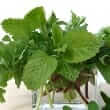Background
- Burnet (Sanguisorba officinalis) is a member of the Rosaceae family and is native to Europe, the Middle East, Asia, and the United States. It grows best in moist, grassy meadows and sandy, loamy, or dense soils.
- The roots of Sanguisorba officinalis are used in traditional Chinese medicine. Referred to as di yu, it is used topically to treat burns and skin rashes and internally to treat diarrhea, duodenal ulcers, bloody stools, bloody cough, and heavy periods.
- Anecdotally, burnet has been used as a source of food, as a substitute for tea, and for a variety of medicinal purposes due to its astringent, hemostatic (stops bleeding), pain-relieving, and healing properties. However, no available scientific evidence supports the use of burnet to treat any condition in humans.
References
- Abad MJ, Guerra JA, Bermejo P,et al. Search for antiviral activity in higher plant extracts. Phytother Res 2000;14(8):604-607. View Abstract
- Bastow KF, Bori ID, Fukushima Y, et al. Inhibition of DNA topoisomerases by sanguiin H-6, a cytotoxic dimeric ellagitannin from Sanguisorba officinalis. Planta Med 1993;59(3):240-245. View Abstract
- Bedoya LM, Sanchez-Palomino S, Abad MJ, et al. Anti-HIV activity of medicinal plant extracts. J Ethnopharmacol 2001;77(1):113-116. View Abstract
- Hachiya A, Kobayashi A, Ohuchi A, et al. The inhibitory effect of an extract of Sanguisorba officinalis L. on ultraviolet B-induced pigmentation via the suppression of endothelin-converting enzyme-1alpha. Bio Pharm Bull 2001;24(6):688-692. View Abstract
- Kim TG, Kang SY, Jung KK,et al. Antiviral activities of extracts isolated from Terminalis chebula Retz., Sanguisorba officinalis L., Rubus coreanus Miq. and Rheum palmatum L. against hepatitis B virus. Phytother Res 2001;15(8):718-720. View Abstract
- Liao H, Banbury LK, Leach DN. Antioxidant activity of 45 Chinese herbs and the relationship with their TCM characteristics. Evid Based Complement Alternat Med 2008;5(4):429-34. View Abstract
- Liu X, Cui Y, Yu Q, et al. Triterpenoids from Sanguisorba officinalis. Phytochemistry 2005;66(14):1671-1679. View Abstract







